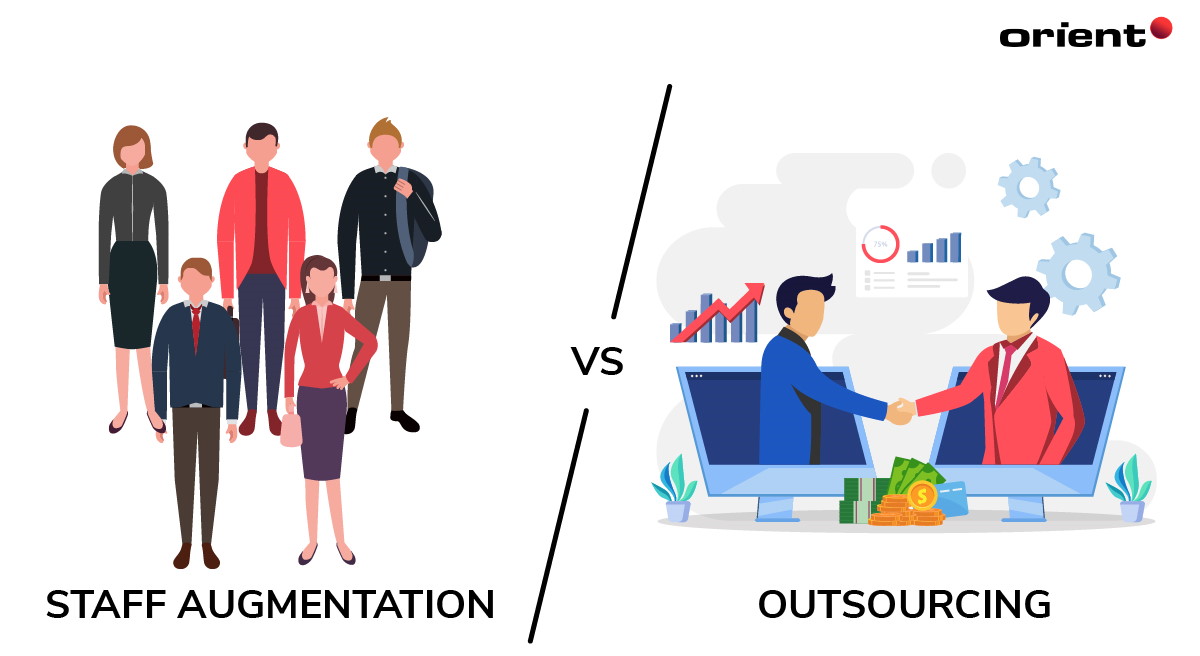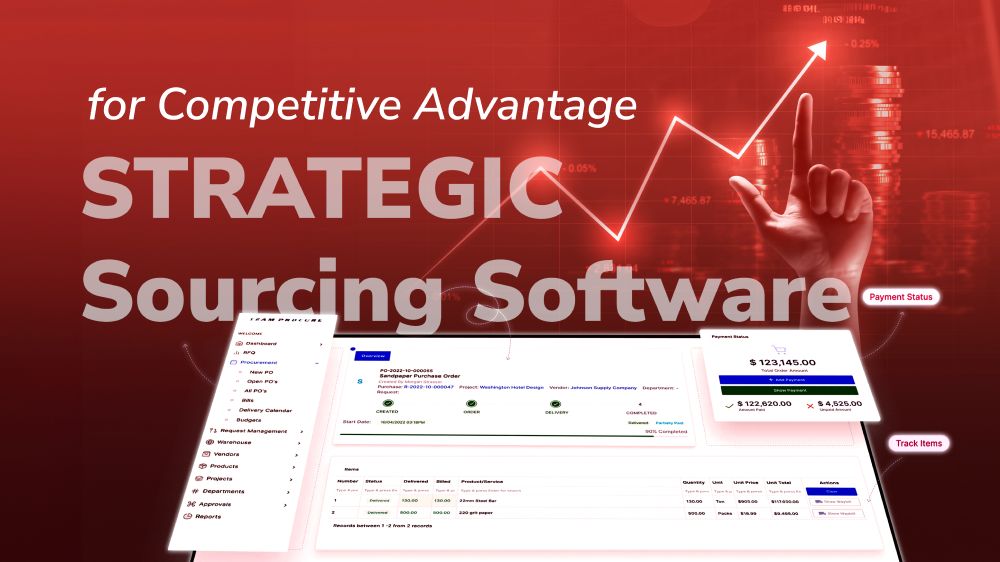Staff Augmentation Vs. IT Outsourcing: 5 Major Differences to Consider

Content Map
More chaptersIt is undeniable that information technology is the industry of the future when the world is increasingly transformed in the process of modernizing all operations. However, the lack of experienced software developers is much more than the reality that today’s market must face and adapt to.
Luckily, outsourcing service comes to the rescue. With numerous benefits like time and cost optimization, increasing operational efficiency, competitive edge, and allowing you to focus on core business, companies tend to transfer their IT jobs to a third party. Outsourcing your IT projects/IT positions to professionals is easier than assembling a local team, which is why outsourced software development for companies, especially startups, is becoming more popular recently.
There are many different cooperation models to go with a software provider, in which staff augmentation and IT outsourcing are considered the two best solutions. However, these two concepts confuse customers when they first learn about outsourcing. The following article will thoroughly analyze the difference between staff augmentation vs. project outsourcing for you to better understand.
What is Staff Augmentation?
Staff augmentation model is an IT outsourcing model that enables customers to hire additional skilled software developers, also known as contractors, in order to work on specific tasks or roles within their project development team. Usually, these resources only work in short-term engagement periods depending on the length of a given project and the client’s project requirements.
By using staff augmentation, businesses can quickly and efficiently gain the technical expertise they need without the hassle of a long-term commitment or the time-consuming process of screening and hiring permanent employees. This can be done by having the augmented staff work along with the in-house team at the customer’s office spaces or remotely from their own home/location.
With staff augmentation services, businesses are able to make well-informed decisions about which skill sets are needed for the successful completion of their entire project. This way, the project manager easily gets access to specialized professionals who have the right knowledge and experience for the job as quickly as possible, without worrying about any extra costs or complications that come with conventional hiring practices.
What is Project Outsourcing?
IT outsourcing/project outsourcing is another kind of outsourcing model that involves a third-party vendor taking over certain types of IT functions for another organization to provide information technology services according to specified project requirements and agreements.
At first glance, you can see that the staff augmentation model and project outsourcing are quite similar. However, instead of providing customers with a specific augmented staff to fill in the skill gap within the organization while maintaining direct control over their development team, project outsourcing offers customers a dedicated team and service to take care of and build the whole software development life cycle. With project outsourcing, you do not need to worry about the quality of the output product or the development process when everything has been taken care of by the outsourcing vendor.
Project outsourcing will recruit, train and manage a dedicated team covering a wide range of positions such as engineers, UI/UX designers, quality assurance, etc. These skilled professionals will operate separately from your organization and are responsible for fulfilling the client’s project requirements, ensuring the project timeline as well as improving operational activities on behalf of the internal team.
IT outsourcing is a popular solution for all-size companies, as it provides them with quick and easy access to technologies and practices that they may not have otherwise been able to access or implement independently. By leveraging the knowledge and skill of the external team, businesses can focus on their core competencies while still benefiting from high-quality IT solutions.
What are Managed Services?
Although the title of this article does not mention this term, managed services are yet another outsourcing service that confuses many people when learning about forms of outsourcing. In particular, the big confusion lies in the definition of project outsourcing and management services.
If project outsourcing is the type of service that delivers a specific IT project on time, within budget, and to the agreed-upon specifications, the managed services vendor is responsible for managing and maintaining the client’s IT infrastructure.
Managed services refer to the act of outsourcing certain IT functions and responsibilities to a third-party known as a Managed Service Provider (MSP). The MSP oversees maintaining, monitoring, and managing the client’s IT infrastructure on their behalf and effectively administering that it operates smoothly and effectively.
Managed services include a wide range of IT functions, such as network monitoring, data backup and recovery, quality control, cloud services, cybersecurity, and more. By outsourcing these critical IT functions, businesses can free up their internal capabilities to focus on more strategic initiatives while also benefiting from the MSP’s expertise and advanced tools, which they may not have access to in-house.
Major Difference Between Staff Augmentation Vs. IT Outsourcing
After going through the general definition of the concepts of staff augmentation and IT outsourcing, below is a specific comparison of the differences between the two outsourcing models that you may be interested in.
General Overhead Costs
The definition of staff augmentation and project outsourcing vendor above has given you a quick look at the cost-effectiveness when using these two kinds of outsourcing models. Overall, both are great solutions to improve software development budget efficiency while helping businesses eliminate the expensive costs of the internal processes of hiring and training full-time employees. However, staff augmentation vendors are usually more cost-effective than IT outsourcing.
Staff augmentation provider involves hiring contractors for specific jobs that project managers need at the time. So, the cost for you to maintain this outsourced team is usually short-lived. By not being in-house programmers, these contractors are typically off the client’s payroll. As such, there are no long-term costs, such as employee benefits or salaries, associated with these contractors.
Meanwhile, a project outsourcing company requires a much larger upfront investment compared to staff augmentation. Why? Because a project outsourcing agency involves a more comprehensive outsourcing of IT functions, this model contract is generally long-term and may involve a range of services and different positions of a dedicated team. The development process is a very long process, from ideation to product completion. Realizing a customer’s idea takes more than application development. Outsourcing teams, in addition to focusing on building software products, also have to intervene directly in infrastructure management and cybersecurity activities. Heavily investing in infrastructure, staffing, and tools to provide the best output quality to the client is the main reason why hiring project outsourcing vendors is more expensive than using a staff augmentation model.
Main Duties
Both are outsourced services that provide customers with a quick solution for personnel in the IT industry. Still, staff augmentation and project outsourcing clearly distinguish the main duties when serving customers with different purposes.
Staff augmentation is all about hiring skilled professionals for required tasks within a client’s project in-house team. Therefore, augmented staff has a narrower and more specialized scope of activities than project outsourcing, when mainly developers specialize in product development. These professionals usually have specific experience and expertise that matches the task at hand and only serve customers until the task is completed.
On the other hand, IT outsourcing acts as a separate team hired by the customer to oversee the entire software development process. Because it operates separately and has nothing to do with the company’s core business, this kind of service provider is self-sufficient, does outsourcing work on its own, and has more control over project management. IT outsourcing offers various IT functions, from application development and infrastructure management to cybersecurity.
Working Location
Working location is the main difference between staff augmentation and IT outsourcing.
Because the purpose of the customer using staff augmentation service is to fill specific gaps or assemble a team on a temporary basis, the customer can choose a working location for chosen developers. Software engineers can work directly in the office space with the existing team or can work anywhere as a remote development team.
On the contrary, it is regular for the development team of an IT outsourcing service to be composed of remote developers. Remote dedicated team can be located in different geographical locations and act as offshore, nearshore, onshore or even freelancers. Because of working out of the office, it is often more convenient and cost-effective to have the project completed by a remote team. This setup allows outsourcing providers to tap into a global talent pool and provide high-quality development services at a lower cost, making them an attractive option for businesses in need of IT development services.
Project Management
Because the purpose of each type of service is different, the leader of each model and main responsibility for the full project as well as the whole team, is also different.
When it comes to the management of staff augmentation resources, it is usually the responsibility of the client’s project team lead. This person has the primary responsibility of managing the contractors who have been brought in to work on a specific project. Since these resources are hired to work directly with the client’s team, they take direction from the project team lead and work as if they were additional members of the client’s team.
On the other hand, a dedicated team from an IT outsourcing service is generally managed by a third-party vendor. This vendor has its own team lead and management structure that is responsible for managing the outsourced project. This team leader is often located at the outsourcing provider’s headquarters and coordinates with the client’s project team lead. While the IT outsourcing team is responsible for completing specific tasks and projects for the client, they are ultimately accountable to the outsourcing provider’s team lead.
Onboarding
Team augmentation resources can be onboarded swiftly and seamlessly without requiring lengthy hiring processes. These contractors are typically hired on a short-term basis and so can be quickly onboarded.
The project outsourcing model, in contrast, consumes more time onboarding than team augmentation because of the complexity of the dedicated team. IT Outsourcing requires a more significant investment of time and resources in the selection of an appropriate service provider, contract negotiation, and onboarding process. This solution can take time to establish, but once the vendor is onboarded, they will generally take responsibility for a range of IT functions within the client’s organization.
Staff augmentation Vs. IT outsourcing - Which Engagement Model Should You Choose?

The choice between staff augmentation and IT outsourcing depends on your specific needs. Staff augmentation best suits short-term projects that require specific expertise, are managed by the client team lead, and are focused on providing skilled resources to complement the client’s team.
In times when a project evolves or if more resources are needed than anticipated, it’s often easier to scale using project outsourcing than staff augmentation. This service is best for longer-term projects that require a more comprehensive IT solution and have a broader range of expertise across multiple IT functions.
However, no matter what form of outsourcing you choose, do not forget to learn carefully about the service provider to avoid wasting time and money on the wrong partner. There are many practical tips for choosing the right outsourcing vendor. One of the good ways is to consult their portfolio and past clients they have worked with in the past to get a more specific view of the third party you are about to cooperate with. Orient encourages you to take it slow in this process for the best outcome!







